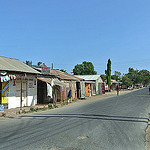 In 2000 the United Nations established the Millennium Development Goals (MDG) designed to improve outcomes for those in low-income countries. These 8 goals range from tackling infectious diseases to reducing extreme poverty and hunger and all have targets to achieve by 2015.
In 2000 the United Nations established the Millennium Development Goals (MDG) designed to improve outcomes for those in low-income countries. These 8 goals range from tackling infectious diseases to reducing extreme poverty and hunger and all have targets to achieve by 2015.
Goal 5 aims to improve maternal health by achieving universal access to reproductive healthcare, such as contraceptives and antenatal care, and by reducing the maternal mortality ratio (MMR) by three-quarters between 1990 and 2015.
The maternal mortality ratio (MMR) is the number of maternal deaths per 100,000 live births. In Kenya the MMR in 1990 was 400 which means the country is aiming to reduce this to 100 by 2015 to achieve the MDG. Since 1990 the MMR initially rose and, whilst it has since decreased to 360, it may not be possible for Kenya to meet this target.
Whilst the MMR gives an overview of the situation there is a need for more nuanced reporting tools to help understand not only the number of deaths, but the causes for these deaths. In a new study published in the International Journal for Equity in Health Elizabeth Echoka and colleagues use the Unmet Obstetric Needs (UON) indicator to look at the situation in Kenya in more detail.
The UON estimates the number of women who would have needed a major obstetric intervention (MOI), such as a caesarean section, to address a life threatening condition (known as Absolute Maternal Indications (AMI)), in a population and compares this to the number who actually received such an intervention to determine whether there is a gap in these services.
The authors collected data on a number of factors, such as MOIs, the maternal indications, geographical origin of the women, and outcomes, for mothers from 4 divisions of the Malindi district, a coastal region to the North of Mombasa, over a 2 year period. This information was then analysed to produce the UON.
 Of the four divisions studied Malindi and Magarini, which are connected to the major trunk road allowing easier access to health care facilities, had UON indicating that the number of MOI performed met or exceeded what would have been expected. However Marafa and Langobaya divisions, which are and not as well connected and also lack an emergency obstetric care facility, had UON rates lower than the benchmark indicating that pregnant women with AMI were not always receiving the treatment they needed.
Of the four divisions studied Malindi and Magarini, which are connected to the major trunk road allowing easier access to health care facilities, had UON indicating that the number of MOI performed met or exceeded what would have been expected. However Marafa and Langobaya divisions, which are and not as well connected and also lack an emergency obstetric care facility, had UON rates lower than the benchmark indicating that pregnant women with AMI were not always receiving the treatment they needed.
Whilst these results, that improved access to healthcare results in better outcomes, are perhaps unsurprising, they highlight the importance in looking in more detail at regions. The picture across the district varied depending on the specific location of the woman. It is also interesting to think that improvements to non-healthcare infrastructure, such as roads, may play as big a role in meeting the MDG as more healthcare focused interventions.
There were limitations of their study, for example the data was analysed retrospectively and as a result it was not possible for researchers to double check facts, such as addresses, with the women.However the use of such nuanced reporting tools may prove useful in allowing governments to make the necessary adjustments to their healthcare services.
Comments